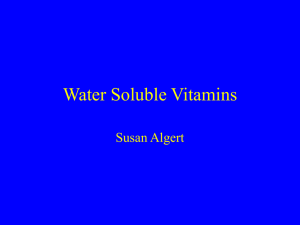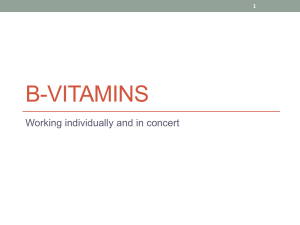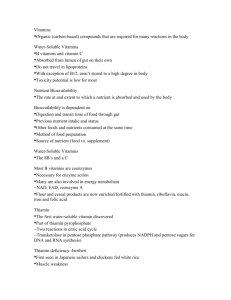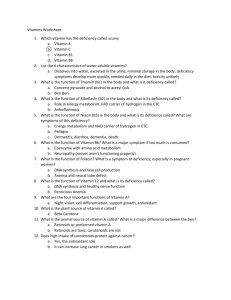Vitamins Water Soluble
advertisement
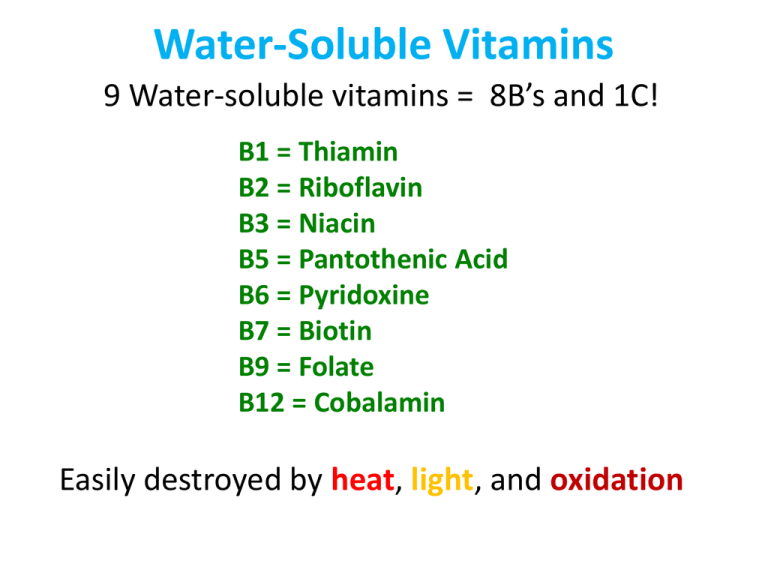
Water-Soluble Vitamins 9 Water-soluble vitamins = 8B’s and 1C! B1 = Thiamin B2 = Riboflavin B3 = Niacin B5 = Pantothenic Acid B6 = Pyridoxine B7 = Biotin B9 = Folate B12 = Cobalamin Easily destroyed by heat, light, and oxidation Digestion and Absorption Primary Functions B vitamins act as coenzymes! Coenzymes are a vital part of some enzymes, so vitamins are needed for enzyme to work properly These Transform carbohydrates, proteins, and fats to ATP • Thiamin • Riboflavin • Niacin • Pyridoxine • Pantothenic Acid • Biotin B Vitamins Function as Coenzymes Primary Functions • Energy Metabolism: B Vitamins – Antioxidant: Vitamin C – Nerve Function: Thiamin – Protein Synthesis: Niacin – Formation of Red Blood Cells: Folate and Cobalamin – Heart Health Promoted by Several B vitamins B Vitamins Function in Energy Metabolism Thiamin (B1) First B vit - *Missing nutrient in unpolished rice. Destroyed in basic solutions; acid solutions protect it. Absorbed - in jejunum (passive diffusion) and active transport if low intakes Produces ATP from Carbohydrate Metabolism – TPP activates decarboxylase to form acetyl CoA. – Convert α-ketoglutarate to succinyl CoA TCA cycle. • Converts branched-chain AA’s to acetyl CoA • Makes pentoses used to synthesize DNA and RNA Thiamin and Thiamin Pyrophosphate (TPP) TPP in Energy Metabolism Thiamin Daily Needs & Food Sources RDA Adults: Males: 1.2mg/day; Females: 1.1mg/day Food Source Asparagus Sunflower Seeds Green Peas Flaxseeds Brussels Sprouts Navy Beans Black Beans Barley Dried Peas Lentils Pinto Beans Lima Beans Oats Sesame Seeds Kidney Beans Tuna Pineapple Serving Size 1 cup ¼ cup 1 cup 2 Tbs 1 cup 1 cup 1 cup ¼ cup 1 cup 1 cup 1 cup 1 cup ¼ cup ¼ cup 1 cup 4 oz 1 cup Amount (mg) 0.29 0.52 0.36 0.23 0.17 0.43 0.42 0.40 0.37 0.33 0.33 0.30 0.30 0.28 0.28 0.15 0.13 DRI/DV (%) 24 43 30 19 14 36 35 33 31 28 28 25 25 23 23 13 11 Nutrient Density 11.0 3.8 4.7 4.6 4.5 2.5 2.8 2.8 2.4 2.2 2.0 2.1 3.0 2.0 1.9 1.5 2.4 Thiamin Deficiency No known Toxicity but Deficiency is Bad!!! Beri Beri Wasting (wt loss), impaired sensory perception, confusion, derangement, muscle weakness, peripheral neuropathy nerve degeneration, arythmia. Classifications: 1) Dry: Peripheral nerve damage, wasting without edema. Psychological disorders. 2) Wet: Edema and congestive heart failure. 3) Infantile: From infancy thiamine deficiency. Wernicke-Korsakoff Syndrome Caused by chronic alcohol abuse depleting thiamin Thiamin Insufficiency ↓ACh, Glutamate and GABA All of these act as neurotransmitters, therefore Decrease in these act to depress transmission of nerve impulses! GABA in Foods! Riboflavin (B2) Two Coenzyme forms – Flavin mononucleotide (FMN) – Flavin adenine dinucleotide (FAD) Heat Stable (cooking) except in UV light Absorption - Attached to proteins in food Released in with HCl in stomach Absorbed by active transport in small intestine Structures of Riboflavin, FAD and FMN Food Sources Involved in E Metabolism Via Oxidation FAD and FMN accept hydrogen ions (H+) FADH2 transports e-s to e- Transport Chain (ETC) makes ATP Metabolic Functions of Riboflavin – Participates in beta-oxidation (Fat Metabolism) – Protects cells from oxidative stress Enhances the function of other B vitamins Riboflavin Daily Needs RDA Adults: Males: 1.3 mg/day; Females: 1.1 mg/day The Role of FAD in the TCA Cycle Riboflavin Deficiency No Toxicity Deficiency Ariboflavinosis – inflammation of tissues lining the throat, mouth, tongue, and lips become. Sore throat, stomatitis, glossitis, cheilosis* Reduced conversion of B6 to its active form Altered iron metabolism & syn of Hb (RBCs) *Fissuring and dry scaling of lips and angles of the mouth Niacin (B3) 2 Active Forms from food: Nicotinic Acid and Nicotinamide • Converted to Coenzymes – Nicotinamide adenine dinucleotide (NAD+) – Nicotinamide adenine dinucleotide phosphate (NADP+) • Bioavailability – Less available in plant foods (wheat grains). – More available in dairy foods and meat. • Absorbed - small intestine, simple diffusion. Niacin is also involved in breaking down alcohol in the body and in the synthesis of fatty acids. Niacin and Coenzymes NAD+ and NADP+ Metabolic Functions of Niacin • Coenzyme in oxidation-reduction reactions – Glucose, protein, fat, and alcohol metabolism – Folate and vitamin C Metabolism • Keeps skin cells healthy and GI tract functioning • In therapeutic doses: – Lowers total cholesterol in the blood – Lowers triglycerides – Raises HDL cholesterol + NAD in Energy Metabolism Daily Needs for Niacin RDA Adults: Males: 16 mg/day; Females: 14 mg/day UL: 35 mg/day • Synthesized in body from Tryptophan – 60 mg of tryptophan = 1 niacin equivalent (NE) – This requires riboflavin, vitamin B6, and iron Niacin Food Sources - Meats, fish, poultry & tryptophan Heat and UV light Stable in Foods • No Toxicity - from food intake! • Excess supplements (and overly fortified foods): • • • • • Reddish coloring of the face, arms, and chest Nausea, vomiting Heartburn Liver toxicity Raised blood glucose levels Niacin Deficiency Pellagra (disease of the 4 Ds) • • • • Dermatitis Diarrhea Dementia Death Pantothenic Acid (B5) • Part of Coenzyme A, then makes acetyl CoA • Absorption - small intestine – If intake is high: Passive diffusion – If intake is low: Active transport Not stored but high conc found in: • Liver • Kidney • Adrenal glands • Brain Pantothenic Acid and Energy Metabolism Metabolic Functions of Pantothenic Acid Used in fat, carbohydrate, and protein Metabolism. – Fat: makes FA’s and converts them to E – Carbohydrate: Converts pyruvate to acetyl CoA – Protein: Converts AA’s substrates in TCA cycle Important in Synthesis of: – Cholesterol – Steroid Hormones – Neurotransmitter Acetylcholine (ACh) Pantothenic Acid Daily Needs and Food Sources Male and female adults: 5 mg/day • Major Food Sources Widespread in a large variety - Eggs, fresh vegetables, wheat bran, yeast, meat, milk… Destroyed by Heat! Processed foods (canned vegetables, fish, meat) are lower than fresh foods in B5. Pantothenic Acid Deficiency No Toxicity • Deficiency: Rare Symptoms: • Fatigue • Nausea • Vomiting • Numbness • Muscle cramps • Difficulty walking Pyridoxine (B6) Vitamin B6 Absorption – 75% is Bioavailable (small intestine) By passive diffusion Bound to albumin and transported to liver Stored mostly in the muscle, some in the liver Metabolic Functions of Vitamin B6 • Coenzyme for more than 100 enzymes! • Mostly Protein Metabolism and AA Metabolism • Req in Transamination of non-essential AAs Involved in: Glycogenolysis and Gluconeogenesis • Makes hemoglobin for RBCs • Assist immune and nervous systems • Reduce risk for Heart Disease • Reduces Nausea and Vomiting B6 Daily Needs and Food Sources RDA Adults Males: 1.3 - 1.7 mg/day; Females: 1.3 - 1.5 mg/day UL: 100 mg/day Wide Variety of Food Sources Meat, fish, poultry Fruits and Vegetables Nuts and Legumes Vitamin B6 Toxicity and Deficiency Toxicity – from excess supplement intake. It attaches to enzymes in muscle and other tissue & remains in body. B6 Deficiency Symptoms – Sore Tongue – Inflammation of the skin – Depression – Confusion Microcytic Hypochromic Anemia Red blood cells are small and pale. Excessive alcohol consumption depletes B6 Biotin (B7) • Contains Sulfur (S)! • Absorption - Biotinidase removes biotin from food. – Active transport in Small Intestine – Absorbed in the liver Metabolic Functions of Biotin • Coenzyme for E Metabolism – Synthesis of Fatty Acids – Amino Acid Metabolism – Replenishes oxaloacetate from pyruvate • DNA replication and transcription of genes • Cell develp & growth - Healthy Hair and Nails Biotin (B7) Biotin Daily Needs and Food Sources • Adults: Males and females: 30 μg/day; Major Food Sources – Yeast – Liver and other organ meats – Bacteria in the GI tract – Egg yolks – Whole grains – Fish – Many Nuts Biotin Toxicity and Deficiency • Toxicity: Very Rare Deficiency: • Can be from eating too many raw egg whites. The Avidin in it binds biotin => deficiency symptoms • Total parenteral nutrition • Impaired absorption • Rare genetic disorders Symptoms: Hair loss, depression, conjunctivitis, dermatitis, lethargy, hallucinations Folate B9 • Folate - the Natural Form of B9 in foods • Folic Acid - synthetic form (added to foods and in supplements) • Extremely important to have optimal Folate during pregnancy. • Most folate in foods = Polyglutamate form. • Absorption – only one glutamate kept during digestion in small intestine • Active form: Tetrahydrofolate - transported to liver. Folate Folic acid is more bioavailable than folate. Folate destroyed with Heat and Light exposure. Raw Foods have more folate than cooked foods. Some foods have enzymes that inhibit folate availability. e.g. Beans, legumes, and cabbage! Metabolic Functions of Folate • • • • Transfers C’s to form new compounds DNA and AA Synthesis Homocysteine metabolism Assists in Neural Tube development prevents: – Neural tube defects – Anencephaly – Spina bifida • May prevent cancer and Heart Disease Daily Needs for Folate Synthetic folic acid absorbed 1.7 times more than Folate. • RDA Adults: Males and females: 400 μg/day • Pregnant women and childbearing age: 400 μg/day – UL: 1,000 μg/day No Toxicity from foods sources of Folate Excess intake fortified food or supplements (mask a B12 deficiency) Food Sources of Folate Dark green leafy vegetables, legumes, seeds and Liver Food Source Lentils Asparagus Spinach Turnip Greens Broccoli Beets Romaine Lettuce Bok Choy Cauliflower Parsley Pinto Beans Garbanzo Beans Black Beans Navy Beans Kidney Beans Papaya Brussels Sprouts Green Peas Bell Peppers Green Beans Serving Size 1 cup 1 cup 1 cup 1 cup 1 cup 1 cup 2 cups 1 cup 1 cup ½ cup 1 cup 1 cup 1 cup 1 cup 1 cup 1 med 1 cup 1 cup 1 cup 1 cup Amount (mcg) 358.38 268.20 262.80 169.92 168.48 136.00 127.84 69.70 54.56 46.21 294.12 282.08 256.28 254.80 230.10 102.12 93.60 86.78 42.32 41.25 DRI/DV Nutrient (%) Density 90 7.0 67 30.5 66 28.6 42 26.5 42 13.9 34 8.2 32 36.0 17 15.4 14 8.6 12 19.0 74 5.4 71 4.7 64 5.1 64 4.5 58 4.6 26 3.9 23 7.5 22 3.4 11 6.7 10 4.2 Folate Deficiency Interferes with normal red blood cell division Megaloblasts → macrocytes → macrocytic anemia RBCs abnormally large! – Macrocytic Anemia – – – – Fatigue Weakness Irritability Shortness of breath Folate Deficiency Linked to Parkinson's Disease Cobalamin (B12) 2 Forms - Both contain Cobalt. The Absorption of Vitamin B12 Vitamin B12 bound to proteins in food and R protein in saliva goes with it to collect it. The protein called intrinsic factor (IF), made in stomach helps the intestines absorb vitamin B12. Vitamin B12 • Stored mostly in the liver • Excreted through the bile and urine • Deficiency can take years to develop. Metabolic Functions of Vitamin B12 • 2 Coenzymes Methylcobalamin: homocysteine to methionine; (prevents homocysteine* buildup) Deoxyadenosylcobalamin: Succinyl CoA in TCA cycle • • • • Activates Folate! Synthesis of new cells, esply RBCs Maintains myelin sheath of nerves Catabolism of AAs and FAs for E Metabolism Daily Needs for Vitamin B12 RDA Adult: Males and Females: 2.4 μg Atrophic gastritis: Reduction in HCl production and B12 not released from protein in food Bad Bacterial overgrowth reduces B12 absorption Absorption of the synthetic form is not hindered Insufficient intrinsic factor & gastric bypass ↓ absorption Microwave cooking reduces active form by 30-40%. Vitamin B12 Deficiency No Toxicity Deficiency: • • • • Zero intake (vegan diets) Malabsorption (HCl) ↓Pancreatic Enzymes Gastric Bypass Macrocytic Anemia Pernicious Anemia Fatigue Shortness of breath Peripheral Neuropathy (tingling & numbness arms/legs) Pernicious, Latin meaning ‘destructive’ Pernicious Anemia is a decrease in healthy red blood cells from lack of vitamin B12. Need to eat meat, poultry, shellfish, eggs, and dairy products to get this vitamin. Food Sources of Vitamin B12 Food Source Sardines Salmon Tuna Cod Lamb Scallops Shrimp Beef Yogurt Cow's milk Eggs Turkey Chicken Cheese Serving Size 3 oz 4 oz 4 oz 4 oz 4 oz 4 oz 4 oz 4 oz 1 cup 4 oz 1 4 oz 4 oz 1 oz Amount (mcg) 8.11 5.67 2.66 2.62 2.51 2.44 1.88 1.44 0.91 0.55 0.55 0.42 0.39 0.24 DRI/DV (%) 338 236 111 109 105 102 78 60 38 23 23 18 16 10 Nutrient Density 32.2 27.0 13.5 20.4 6.1 14.5 10.4 6.2 4.6 5.5 5.3 1.9 1.6 1.6 Vitamin C Ascorbic Acid We Humanoids lack enzyme to make vit C : ( Absorption - Small intestine by active transport Higher intakes => simple diffusion stomach & intestine Absorption decreases 50% with intakes > 1 g More is more likely to be absorbed! Excreted via kidneys, not stored in the body Metabolic Functions of Vitamin C • Collagen Synthesis – Crucial for tissue Health! • Antioxidant – Reduces risk for heart disease and cancer – Accepts/donates e-s to balance free radicals • Iron absorption is enhanced. More Functions of Vitamin C • Boosts the immune system – Promotes WBC synthesis • May reduce the body's response to stress • Aids in the conversion of tryptophan and tyrosine to serotonin and norepinephrine • Aids in the synthesis of thyroxine • Converts cholesterol to bile • Assists with histamine breakdown Daily Needs for Vitamin C RDA Adults: Males: 90 mg/day; Females: 75 mg/day Smokers: + 35 mg/day! UL: 2,000 mg/day Consuming > 3,000mg can cause nausea, stomach cramps, and diarrhea. Vitamin C Toxicity and Deficiency • Deficiency Scurvy Prevented with 10mg of vitamin C per day Scurvy first presents with: Fatigue and then formation of spots on the skin, spongy gums, and bleeding from mucous membranes. Person feels depressed, pale and partially immobilized. Advanced scurvy shows open suppurating (pus filled) wounds, loss of teeth, yellow skin, fever, neuropathy and finally death from bleeding. Other Vitamin-Like Compounds • Some compounds are not vitamins but essential to overall health. • Usually enough made in body • May become essential, e.g., during illness or chronic disease Choline Carnitine Lipoic acid Inositol Choline - cannot be synthesized by body… Grouped with the B vitamins (but not a vit) Major Functions – Part of phospholipid that makes up the cell wall – Liver metabolism – Precursor to acetylcholine (nerve transmission) – Assists in Lipid Transport – For Fetal Development Major Food Sources Animal sources: milk, liver, eggs Carnitine, Lipoic Acid, and Inositol All synthesized by body Carnitine – Needed to properly utilize fat – Food sources = Meat and dairy products Lipoic Acid – Helps cells generate energy – Potential antioxidant effects Inositol – Assists Cell Membranes – Food sources – some plants

